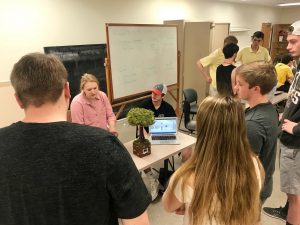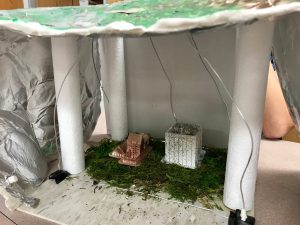1 Responsible Innovation and Ethical Reasoning with Design Fiction

Emily York and Shannon Conley
With an increasing tempo for social, political, economic, technological, and environmental change, college graduates as young professionals and citizens need critical skills for imagining, analyzing, and conducting ethical reasoning about potential futures. Yet critically engaging with potential futures is often reserved for specific disciplines that do this in very different ways. A business education may highlight strategies for identifying market opportunities, or a literature education may provide tools for deconstructing science fiction narratives. Bridging these disciplinary approaches, we are experimenting with strategies that blend three tools in an accessible, hands-on, and flexible way: scenario analysis, design fiction, and the 8 Key Questions.
Scenario analysis is a structured technique for collective brainstorming, analysis, and grounded speculation about future trajectories that can be adapted to a single class session or to an entire semester-long engagement. Design fiction is a visual and narrative technique for envisioning the potential contexts of a material object or policy. The 8 Key Questions refers to a set of questions developed by James Madison University’s Madison Collaborative designed to engage students in ethical reasoning in action.
Our Proposal
Our original ACT Grant Proposal was primarily aimed at securing funding for craft materials to facilitate a design fiction project that would incorporate both 2D and 3D elements. We also asked for funds to support dissemination of our work. Our original proposal can be viewed in its entirety here: Conley York ACT Grant Application_Final. We received positive feedback regarding our detailed funding request, although there were questions about how we could disseminate our work and how we could maintain this work going forward when our supplies inevitably ran out. With regard to dissemination, we have already presented some of our work at Virginia Tech’s Conference on Higher Education Pedagogy, and we also collaborated with the Madison Collaborative to host a Lunch & Learn event at JMU to share our work. Once we analyze our data, we hope to additionally work on a publication. With regard to carrying this project forward, we hope that the success of our first experiment will enable us to seek more resources to continue this work. We also see JMU’s Networked Humanities community along with LET support as critical in potentially using more 3D printing and virtual reality technologies for future projects. This could alleviate the need for purchasing craft materials and obtaining space to develop the design fiction projects.

Lessons
Overall, this project has felt like a huge success, although we will be analyzing students’ reflections this summer to get a more formal sense of how design fiction helped them to apply ethical reasoning to potential futures. We have also learned a few things so far:
- Try to consider all of the logistical requirements of your proposal. In our case, we imagined a fantastic project with lots of art supplies, but we never considered what space we might need to actually do the project. It wasn’t until well into the semester that it occurred to us that having students working with clay and paint and other materials in our regular classrooms would create a lot of mess, and create various constraints on how much time we could allot for the project. Fortunately, with the assistance of our Assistant Dean and Dean and AUH, we were able to get a large empty room destined for summer renovations to do our projects, and that was fantastic.
- Try to consider all of the material requirements of your proposal. In our case, we purchase a lot of materials, but did not initially purchase any form of adhesive–no glue, no tape, nothing to make things go together–nor did we think about the need for a good set of shears. Fortunately were able to purchase those things separately.
- Consider how much scaffolding and reflection time students will need to make the most of the experience.
Next Steps
Applying for this grant and incorporating these tools into our classroom has also helped inspire us to create a more permanent lab to continue developing these strategies with students. We are establishing the STS Futures Lab, which will soon have an associated live website. We will be analyzing our data, and figuring out what kinds of improvements we can make to the process to facilitate a deep and meaningful learning experience for our students.

